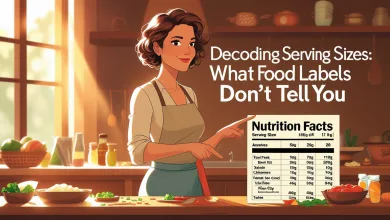Trans Fats and Partially Hydrogenated Oils: How to Spot Them on Labels

The Stealth Ingredients Lurking in Your Shopping Cart
Trans fats and partially hydrogenated oils are the food industry’s dirty little secret — ingredients that boost shelf life and profits while potentially compromising your health. In today’s maze of confusing food labels, knowing how to spot these troublemakers has never been more crucial.
Holy moly, who knew grocery shopping could feel like defusing a nutritional time bomb? You’re standing there in aisle seven, squinting at microscopic ingredients lists, wondering if you need a chemistry degree just to figure out what’s in your crackers. Don’t worry, you’re not alone in this confusion. The world of trans fats and partially hydrogenated oils is deliberately mystifying, with manufacturers often playing a sophisticated shell game with terminology.
Let’s face it — food labels weren’t designed with your convenience in mind. They’re regulatory requirements that companies have learned to navigate with impressive creativity. Today, we’re pulling back the curtain on these sneaky ingredients. By the time you finish reading, you’ll be spotting these health-sabotaging substances like a nutritional detective. Your heart (and your family’s hearts) will thank you for the effort.
The Science Behind Trans Fats: Not All Fats Are Created Equal
Trans fats might sound like just another type of fat, but they’re in a dangerous league of their own. Unlike naturally occurring fats that your body knows how to process, industrial trans fats are manufactured imposters that wreak havoc on your cardiovascular system. They’re created through a process called hydrogenation, where hydrogen is added to liquid vegetable oil to make it more solid and shelf-stable.
The chemistry is fascinating, if somewhat alarming. By forcing hydrogen into oil under pressure, manufacturers literally transform the molecular structure of the fat. The result? A substance that’s fantastic for extending shelf life and maintaining texture in processed foods, but catastrophic for your arteries. Trans fats simultaneously raise your “bad” LDL cholesterol while lowering your “good” HDL cholesterol — essentially a double whammy to your heart health.
“The relationship between trans fat consumption and coronary heart disease risk is stronger than for any other macronutrient,” reports the American Heart Association. In fact, research suggests that for every 2% increase in energy intake from trans fats, the risk of coronary heart disease increases by a whopping 23%.
The Regulatory Landscape: Has the Ban Really Eliminated Trans Fats?
You might’ve heard that trans fats are “banned” in the United States, and you’d be partially right. In 2015, the FDA determined that partially hydrogenated oils (the primary source of artificial trans fats) were no longer “Generally Recognized as Safe” (GRAS). They gave food manufacturers until June 2018 to remove them from products, with some extensions granted until January 2020.
But here’s the kicker — this doesn’t mean trans fats have completely disappeared from your food supply. Far from it! There are several significant loopholes that allow these troublemakers to continue sneaking into your shopping cart:
- Products can still be labeled as “0 grams trans fat” if they contain less than 0.5 grams per serving
- Certain foods may have been granted extensions beyond the general ban
- Naturally occurring trans fats (found in some meat and dairy) aren’t covered by the regulations
- Imported products may not adhere to the same standards
And let’s not forget the most frustrating part: manufacturers are incredibly adaptable. Many have simply replaced partially hydrogenated oils with other problematic ingredients that might prove to be just as concerning in the long run. It’s nutritional whack-a-mole, and you’re caught in the middle of the game.
Label Detective: The Many Disguises of Trans Fats and Partially Hydrogenated Oils
Alright, now we’re getting to the good stuff! Trans fats and partially hydrogenated oils are masters of disguise, often hiding behind obscure terminology or sneaky labeling practices. Let’s crack the code together.
First off, the term “partially hydrogenated oil” is your most obvious red flag. If you see these words, put the product back on the shelf — no ifs, ands, or buts. This is the primary source of artificial trans fats and has no place in a heart-healthy diet. But manufacturers know you’re looking for this phrase, so they’ve gotten craftier with their wording.
Here are some other terms that should set off alarm bells:
- Hydrogenated oils (fully hydrogenated oils aren’t technically trans fats, but they’re still highly processed)
- Shortening
- Modified oils
- Mono and diglycerides
- Some forms of “vegetable oil” (especially if unspecified)
Beyond the ingredient list, there are other clues to watch for. Any product promoting its “flakiness,” extended shelf life, or stable texture might be suspicious. Classic culprits include:
- Packaged baked goods (especially those that stay “fresh” for weeks)
- Microwave popcorn
- Frozen pizza
- Coffee creamers
- Stick margarines
- Fast food items (particularly fried foods)
- Ready-to-use frostings
Don’t forget about serving sizes — they’re perhaps the most insidious trick in the manufacturer’s playbook. A product can claim “0g trans fats” if it contains less than 0.5g per serving. But who actually eats just two cookies or a quarter cup of crackers? Those “zero” grams can add up quickly when you consume realistic portions.
The Health Impact: Why These Ingredients Deserve Your Scrutiny
Let’s not mince words here — trans fats are bad news for your body. Like, really bad. There’s a reason the World Health Organization has called for their global elimination. These artificial fats don’t just contribute to heart disease; they’re active accomplices in harming your health.
The cardiovascular effects alone are staggering. Trans fats cause inflammation, promote insulin resistance, and contribute to the development of atherosclerosis (hardening of the arteries). One meta-analysis found that increasing trans fat consumption by just 2% of daily calories was associated with a 23% higher risk of coronary heart disease.
But the damage doesn’t stop there. Research has linked trans fat consumption to:
- Increased risk of stroke
- Higher levels of systemic inflammation
- Greater risk of type 2 diabetes
- Possible negative effects on brain health and cognitive function
- Potential connections to some cancers
And unlike some dietary villains that might have redeeming qualities in moderation, trans fats have no known health benefits. Zero. Zilch. Nada. The Institute of Medicine stated that there is “no safe level of consumption of artificial trans fat” and that people should eat as little as possible.
When you consider that cardiovascular disease remains the leading cause of death globally, taking steps to eliminate these dangerous fats from your diet seems less like dietary pickiness and more like basic self-preservation.
Healthier Alternatives: What Should You Choose Instead?
Now that I’ve thoroughly terrified you about trans fats (sorry not sorry — they really are that bad!), let’s talk solutions. What should you be reaching for instead?
Fortunately, there are plenty of healthier fat options that not only avoid the dangers of trans fats but actually contribute positively to your health:
- Extra virgin olive oil: Rich in monounsaturated fats and antioxidants, it’s the cornerstone of the heart-healthy Mediterranean diet
- Avocado oil: High smoke point makes it great for cooking, plus beneficial monounsaturated fats
- Nuts and seeds: Nature’s perfect packages of healthy fats, protein, and fiber
- Fatty fish (like salmon and mackerel): Excellent sources of omega-3 fatty acids
- Real butter (in moderation): Yes, it’s high in saturated fat, but it’s natural and free from industrial processing
When shopping for processed foods (because let’s be real, we all buy them sometimes), look for products that use these healthier oils instead of the suspicious “partially hydrogenated” or generic “vegetable oil” listings. Many forward-thinking companies now proudly advertise their use of healthier fats — let your dollars support these better choices.
And remember, whole foods rarely come with ingredient lists at all! The more you can center your diet around foods that don’t require labels — fresh vegetables, fruits, legumes, whole grains, and quality protein sources — the less you’ll need to play detective with confusing terminology.
Real-World Application: Practical Tips for Your Next Shopping Trip
Alright, enough theory — let’s get practical. You’re heading to the grocery store tomorrow, and you want to avoid trans fats like the plague they are. Here’s your battle plan:
First, develop the habit of always flipping the package over. The front label is marketing; the back label is (somewhat) regulated information. Colorful claims of “all natural” or “heart healthy” mean nothing if the ingredient list tells a different story.
When examining products, follow this quick checklist:
- Scan the ingredient list for any form of “hydrogenated” oils
- Check if the product claims “0g trans fat” but contains suspicious ingredients
- Consider the shelf stability — unnaturally shelf-stable products often contain preservatives like trans fats
- Be especially vigilant with known offenders: baked goods, snack foods, and fried items
- Watch for serving sizes that seem unrealistically small
Shopping the perimeter of the store is another tried-and-true strategy. That’s where you’ll typically find fresh produce, meats, dairy, and other minimally processed foods. The inner aisles are where processed foods — and their mysterious ingredients — tend to lurk.
When in doubt, choose products with shorter, simpler ingredient lists. As food writer Michael Pollan famously advised, don’t eat anything your great-grandmother wouldn’t recognize as food. She definitely wouldn’t recognize “partially hydrogenated soybean oil with TBHQ for freshness” as something edible!
Global Perspective: How Different Countries Handle Trans Fats
It’s fascinating (and sometimes frustrating) to see how differently various countries approach the trans fat issue. While some nations have taken aggressive stances against these harmful substances, others lag behind, leaving their populations vulnerable.
Denmark led the charge way back in 2003, becoming the first country to effectively ban industrially produced trans fats. Their restriction limited trans fats to just 2% of total fat in food products. The result? A dramatic decrease in cardiovascular deaths — approximately 70% of which was attributed to this policy change alone.
Other countries that have implemented strict trans fat regulations include:
- Canada: Ban on partially hydrogenated oils since 2018
- Switzerland: Limited trans fats to 2% of total fat content since 2008
- Austria, Hungary, Iceland, Norway, and Sweden: Various forms of restrictions
- Many Latin American countries: Progressive policies led by Brazil and Chile
The World Health Organization has set an ambitious goal of eliminating industrially produced trans fats from the global food supply by 2023 through their REPLACE initiative. However, implementation varies widely, and enforcement remains a challenge in many regions.
If you’re a traveler or an expat, this patchwork of regulations means you can’t assume the same standards apply everywhere. Products that would be reformulated or banned in one country might still be loaded with trans fats in another. Always check labels, no matter where you are!
FAQs: Your Burning Questions About Trans Fats Answered
Is butter better than margarine?
It depends on the margarine! Traditional stick margarines often contained significant amounts of trans fats, making them worse choices than butter. However, many modern margarines and spreads have been reformulated to eliminate trans fats. Look for soft tub margarines that specifically state “no trans fats” and avoid those listing partially hydrogenated oils. If choosing between regular butter and old-school trans fat-containing margarine, butter is indeed the healthier choice.
Are all hydrogenated oils equally bad?
No, they’re not. Partially hydrogenated oils are the primary dietary source of artificial trans fats and should be avoided. Fully hydrogenated oils, however, don’t contain trans fats because the hydrogenation process is complete. That said, fully hydrogenated oils are still highly processed and not the healthiest choice, even though they don’t pose the same specific risks as trans fats.
If a product claims “0g trans fat,” is it completely free of trans fats?
Unfortunately, no. Due to labeling regulations, products can claim “0g trans fat” if they contain less than 0.5 grams per serving. This means they could contain up to 0.49 grams per serving — and if you eat multiple servings (which most of us do), you could still be consuming significant amounts of trans fats. Always check the ingredient list for partially hydrogenated oils, regardless of the nutrition facts panel.
Are there any natural sources of trans fats?
Yes, small amounts of trans fats occur naturally in some animal products, including meat and dairy from ruminant animals like cows and sheep. These natural trans fats (like conjugated linoleic acid or CLA) are different from industrial trans fats and may even have some health benefits. The trans fats to worry about are the artificial ones created through partial hydrogenation.
How quickly can I improve my health by eliminating trans fats?
Good news! Your body can begin recovering from the effects of trans fats relatively quickly. Studies suggest that inflammatory markers and lipid profiles start improving within weeks of reducing trans fat intake. While reversing accumulated arterial damage takes longer, you’re preventing further harm with every trans fat-free day.
Final Thoughts: Empowerment Through Knowledge
We’ve covered a lot of ground in our exploration of trans fats and partially hydrogenated oils. From the deceptive labeling practices to the serious health consequences, it’s clear that these ingredients deserve our scrutiny and avoidance. But rather than feeling overwhelmed by this information, I hope you feel empowered.
Knowledge is power when it comes to your health. Every time you flip over a package to check the ingredient list, you’re taking control of what goes into your body. Every time you choose a product with healthier fats, you’re casting a vote for better food industry practices. These small decisions add up over time, both for your personal wellbeing and for our collective food environment.
Remember, nobody’s perfect, and the occasional treat containing less-than-ideal ingredients isn’t the end of the world. The goal isn’t perfection but progress — making informed choices more often than not. By understanding how to spot trans fats and partially hydrogenated oils on labels, you’ve added a valuable skill to your nutritional toolkit.
So the next time you’re navigating the supermarket aisles, armed with your new label-reading superpowers, take a moment to appreciate how far we’ve come. Just a couple of decades ago, these harmful ingredients were ubiquitous and largely unrecognized. Today, we’re moving toward their elimination, one informed consumer at a time.
Your heart — and your future self — will thank you for the attention you’re paying today.





